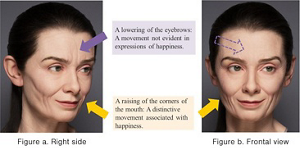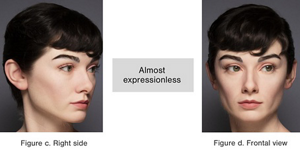Art × Science: Face Project
The Coexistence of Various Expressions Brings out the Radiant Individuality of a Face:
Analyzing the Audrey Hepburn Sculptures by Kazu Hiro
This is an English translation of a news release in Japanese on December 22, 2020.
The Sensory Science and Skincare Laboratories of Kao Corporation have analyzed two facial busts of Audrey Hepburn, created by the contemporary artist Kazu Hiro. Using an analytical tool called the Facial Action Coding System (FACS)*1 , Kao researchers found that small movements of the face that express emotions were perceived differently when viewed from different angles.
Kazu Hiro animated his faces by portraying an inner self and experiences that changed and matured in the course of her life. Kazu's faces masterfully convey an individuality that emanates from within. The results of this research were presented at the 25th Annual Congress of the Japanese Academy of Facial Studies, a forum held online on the 3rd and 4th of October, 2020.
-
* 1 A method developed by Ekman, Friesen & Hager (2002) to objectively rate the strength of "action units," the smallest visually discriminable movements of the face that make up expressions.

Background
When we think of someone as being beautiful, the impression often stems not just from the outward form of their face, but from beauty that seems to emanate from within. While experience helps us understand that individuality and attitudes about life are reflected in the expressions of a face, few of us can discern the diverse and complicated components that make up beauty when observing from a single viewpoint.
Researchers at Kao have been trying to understand the attractiveness of a "face radiant with individuality," and how a face expresses a person's lifestyle and values. In 2019, they embarked on a new phase of their work in a joint project with Kazu Hiro, a leading special makeup artist and contemporary artist. While Kazu's facial busts of Audrey Hepburn are double life size, they animate his subject's inner self with great fidelity. With help from FACS and discussions with Kazu, the project revealed how the attractiveness of a subject's personality and inner nature expressed in a face can be reproduced in sculpture by a perceptive artist.
The sculptures
The objects of this study were a pair of double life-size facial sculptures of Audrey Hepburn, created by the artist Kazu Hiro. The first of the sculptures depicted a young Audrey; the second, Audrey towards the end of her life. The changes with age expressed in the sculptures reflect how Hepburn's inner self changed as her experience grew.
Kazu Hiro's creative process: Expressing the subject's inner life in sculpture
Before starting these works, Kazu studied his subject's biographies, photographs, and newsreels and films. He wanted to understand not just her experiences, but how they changed her and were expressed in her face. In his two sculptures, Kazu explains, the aspects of Audrey's personality he discovered by studying her life are reflected in expressions of emotions such as sadness, happiness, and anger.
Kazu Hiro is not representing a single moment from Audrey's life experience in an inanimate sculpture. Rather, he is expressing a continuity of emotions and expressions that captures Audrey's total life experience. By expressing varied emotions, Kazu's sculptures can connect directly with viewers and resonate with their own situations and states of mind.
FACS analysis: Contradicting emotions expressed at once
Kao researchers used FACS, a system developed by Paul Ekman and his colleagues, to explore how the aims informing Kazu's creative process are reflected in the completed sculptures of Audrey. First, the expressions of the face as a whole were divided into detailed "action units," small movements of the facial muscles, such as a lowering of the eyebrows or a raising of the corners of the mouth. Next, a group of four certified FACS encoders rated the intensity of each action unit by viewing photographs of the two sculptures taken from nine horizontal directions.
The FACS action unit ratings revealed that Audrey's faces express contradictory emotions even when viewed from the same angle. In Figure a, the image photographed from the right side of Audrey's face, for instance, the FACS encoders observed both a lowering of the eyebrows and a raising of the corners of the mouth. While the latter action unit expresses happiness, the former expresses something different. Upon seeing these movements taking place together, at the same time, the observer is likely to perceive a variety of emotions.

When viewed from different angles, the intensities of the action units also varied. While the raising of the corners of the mouth seen on the right side of the sculpted face was rated with the same intensity when viewed directly from the front, the lowering of the eyebrows was scarcely visible from the latter view (see Figure b). The sculptures conveyed a sense of gentility and kindness when viewed from one angle and a strong sense of severity when viewed from another. The FACS analysis thus provided objective evidence that expressions can vary when viewed from different angles. This variability of expression may help explain how Kazu can create sculptures that resonate directly with the viewer.

While the relative intensity of each expressive movement tended to vary with the angle of vision in the sculpture of the young Audrey, the expressive movements were rated with an extremely low intensity (see Figures c and d). In the sculpture of the older Audrey, the various emotional experiences in her life seemed to be expressed with greater intensity in her expressive movements.
Conclusion
Kazu Hiro's aim in creating his Audrey sculptures was to imbue various emotions into inanimate materials and express the complex inner life of the subject dynamically, with emotions that change with shifts in the angle of view. The FACS analysis proved that Kazu achieved exactly what he set out to do. The complex expressions revealed in the sculpture of the older Audrey convey the wide-ranging experience of her life, and the depth and richness of her inner life formed through that experience. A person's individuality seems to show in the expressions of the face. Expressions that reveal a person's inner seem to be important for knowing a person.
In the future, Kao will be using these findings to develop more technology and data to bring out and enhance the inner attractiveness of every person.
* These sculptures are not facsimiles of Audrey Hepburn's face, but interpretations by the artist.


About Kao
Kao creates high-value-added products that enrich the lives of consumers around the world. Through its portfolio of over 20 leading brands such as Attack, Bioré, Goldwell, Jergens, John Frieda, Kanebo, Laurier, Merries and Molton Brown, Kao is part of the everyday lives of people in Asia, Oceania, North America and Europe. Combined with its chemical division, which contributes to a wide range of industries, Kao generates about 1,500 billion yen in annual sales. Kao employs about 33,000 people worldwide and has 130 years of history in innovation. Please visit the Kao Group website for updated information.
Media inquiries should be directed to:
Corporate Communications
Kao Corporation
